Constantinople of the 12th century: on the road to disaster
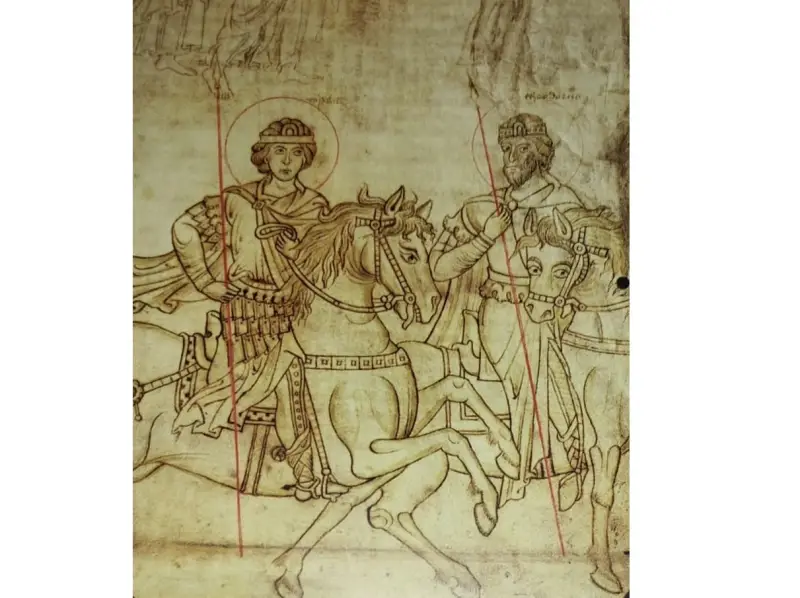
Jesus and St. George. Sketch sheet for a book. XIII century Augustinian Museum. Freiburg. Germany
When Emperors Destroy an Empire
In 1158, Emperor Manuel I, after the defeat of his expedition in Calabria, signed a peace treaty with King William I of Sicily (1126–1166). He renounced his claims to possessions in Italy, thereby falling out with his former ally against the Sicilians, the German Emperor Frederick Barbarossa.
The Emperor of Byzantium tried to ally with the Pope and the northern cities of Italy, now at war with Frederick.
But after the defeat in 1176 at the Battle of Myriokephalon, the military forces of the empire were significantly undermined; the empire could no longer influence either Antioch or the Seljuk states and switched to a defensive defense in Asia Minor. While in Venice in 1177, Frederick Barbarossa made peace with the pope and the Lombard cities. This put an end to the Romans' claims to a universal European empire.
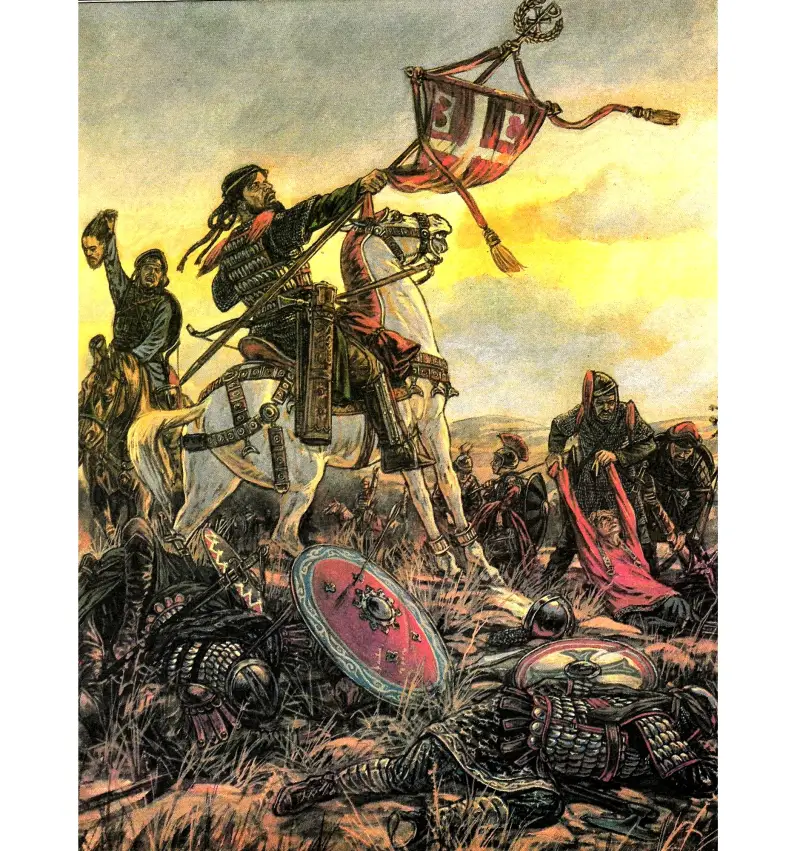
Emperor Manuel, who paid more attention to the brilliance of his foreign policy actions, lost his sense of proportion, spending the remaining resources of the country on stupid imperial ambitions. During short breaks from knightly exploits and campaigns, he was occupied with hunts and feasts, and not with the organization of his multi-ethnic, weakened, but still empire.
Therefore, the sudden death of the king in 1180 brought confusion into the internal politics of Byzantium. His son was only eleven years old. His mother Maria of Antioch became regent under the young Emperor Alexei II. She relied on the Latins who lived in the capital. In 1182, Manuel's cousin, Andronicus, marched on the capital, announcing that he wanted to protect the 13-year-old basileus from bad advisers. And in Constantinople the massacre of the Latins began, everyone was killed: adults, women, children.
64-year-old Andronikos usurped power, killing everyone who stood in his way, including the young Emperor Alexius. But with actions in the style of “beat your own so that others are afraid,” he could not influence foreign policy in any way.
Clouds were gathering over the empire: in 1184, Barbarossa’s son and heir, Henry, married the aunt and heiress of William II (1153–1189) of Sicily, Constance.
Constantinople: under attack again
The troubles that such an alliance could cause were not long in coming. Not only did he lose Dalmatia during the war with Hungary, but in the same 1185 the Sicilians landed at the ill-fated Dyrrhachium, battles around which took place with the Normans exactly a hundred years ago (1081–1082) under Emperor Alexius I Comnenus. Epidamnus or Dyrrachium (Durres, Albania), the key city to the Adriatic coast, surrendered without a fight. And just like during the uprising of Nikephoros Bryennin, exactly 110 years later the enemy troops moved along Via Egnatia to Thessalonica. This road, Via Egnazia, led directly to the Golden Gate of Constantinople, which was closed at that time.
In August 1185, the assault on Thessalonica began, at the head of the defense was David Komnenos, a man who was not distinguished by intelligence, one of the haters, who unreasonably despised the Norman opponents. After a brutal assault, the second city of the empire fell, the Normans committed a massacre here in revenge for the Constantinople pogrom:
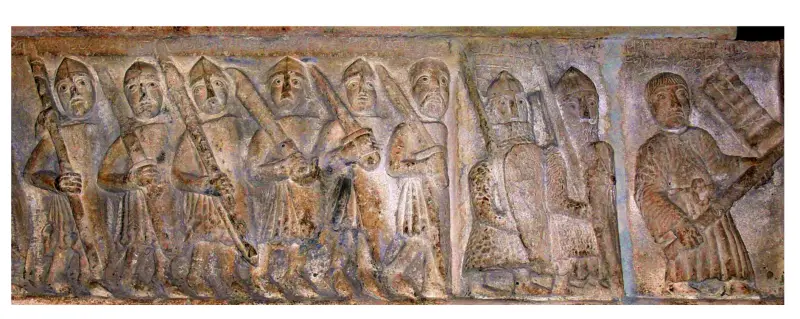
Image of Latin warriors. Stone from Porto Romano. 1178 Sforza Castle. Milan. Italy. Photo by the author.
The path to the capital was clear, and Alexei Comnenus, the grandson of Emperor Manuel, who was in the Sicilian camp, encouraged an attack on the city. The enemy was in the area of Amphipolis, on the Strymona River (Strimonas), and Mosinopolis (near Komotini, Greece), 460 km from the capital. Here he set up a camp and from here he carried out raids.
He no longer engaged in defense, but continued his leisure time, interspersed with reprisals against the dissatisfied. What caused the uprising of the people of Constantinople, who feared a siege. During the uprising, he was brutally executed, and Isaac II Angel, who did not bother himself with affairs, became emperor.
At this time, the commander Alexei Vrana, who was sent on a campaign, with the Alan mercenaries, approached the Sicilian army and suddenly defeated them on November 7, 1185.
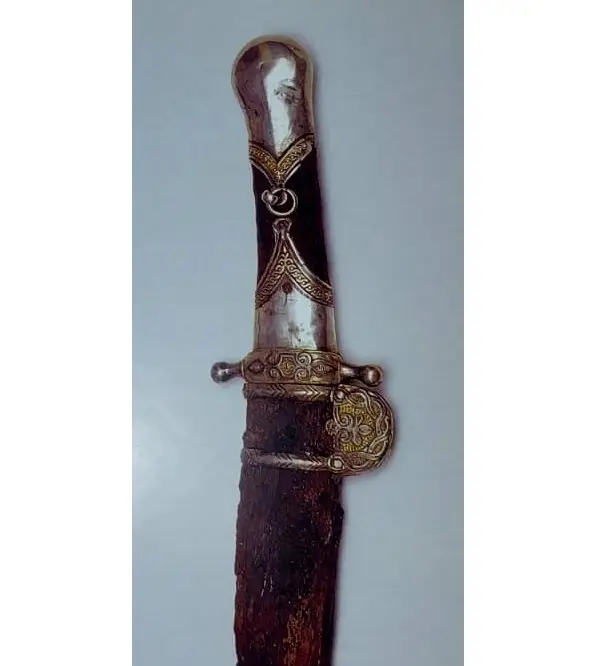
Alan saber. X–XII centuries Fragment. Length 103 cm. North Ossetia. Art. Zmeyskaya. Excavations 1957
Thus, without even beginning, the expedition to the walls of Constantinople was completed.
A new usurper at the walls of Constantinople
But the commander himself began to think about the royal crown. After the defeat of the Sicilians, he was sent to fight the Bulgarians and Vlachs. There he showed his best side, and detachments of German mercenaries were placed under his command. With them he came to Adrianople (modern Ederne), the key city to Constantinople. Here, with the support of his Adrianople relatives, he was dressed in red sandals, and from here he moved to the walls of the city in the spring of 1187.
Now it was not the Western kings, but the usurper who entered the country palace of Philopation, located opposite the Selimvri Gate. Vrana's entire army was tested in battles with the Hungarians, among them the Sicilian warriors whom he captured in 1185 stood out.
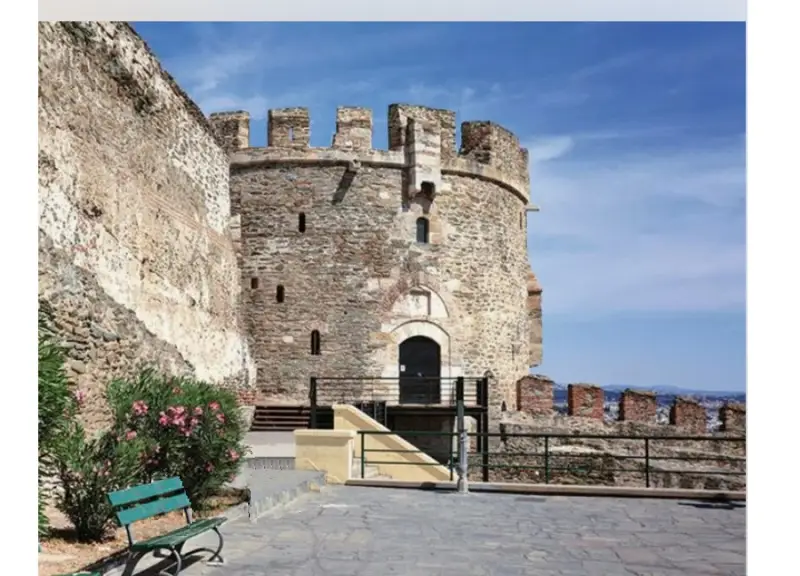
The walls of the Thessalonica fortress. Thessaloniki. Greece
Alexey Vrana, who had already rebelled against the king in Constantinople, but was forgiven, moved to the walls of the city:
He threatened the townspeople and the army, and promised untold riches. But his appeal was in vain, so the next day the assault began.
Unlike the global sieges of previous periods, the siege, if you can call it that, was concentrated on one, eighth from the Propontis, the Charisian or Adrianople gates.
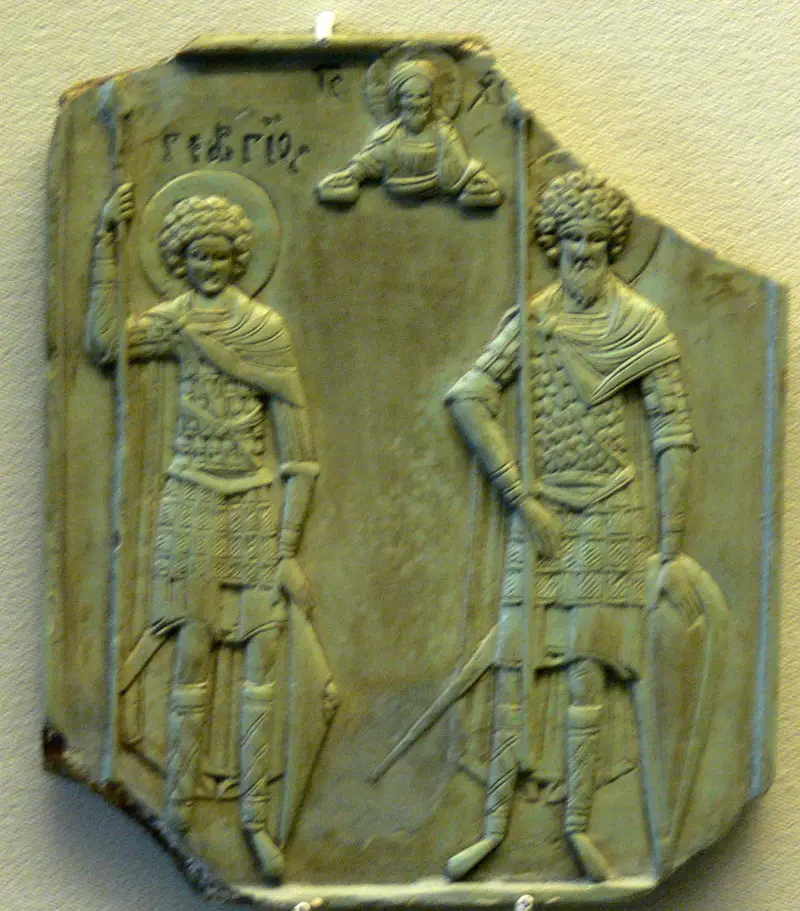
Byzantine warriors of the 12th century. "George and Fedor stratilat." Icon. XII century Byzantium. State Historical Museum Moscow. Russia. Photo by the author
Isaac's troops stood both on the walls and in the field opposite the gate, and Vrana began the battle, which came down to skirmishes. The advantage was on the side of the experienced rebel troops, and a blow from the Sicilians threw the royal army back beyond the gates. The rebels rested for five days and began to attack again.
Part of the army crossed the Golden Horn and, “blowing banners” and “shining armor,” began to threaten the city from the north. Such actions without the presence of watercraft were just bragging. Vrana decided to attack from the north, across the Golden Horn. To do this, he attracted fishermen, weak warriors, but skilled rowers:
Of course, the sailors retreated from the first blow and were ready to crush the fishermen’s boats, but the rebel troops that arrived in time and were on the shore cooled their ardor.
It is significant that if quite recently, even Andronik, who had gone crazy during the repressions, had about a hundred dromons, now there were so few of them that they could not withstand the boats.
Alexey Vrana did not have enough troops to take the city by force, and he decided to blockade it in order to force it to surrender through hunger. Moreover, all the territories around the capital recognized his power.
Isaac II Angel decided to resort to the last means of protecting the Great City, placing on the wall “an irresistible and indestructible fence, the icon of the Mother of God of Odygia.” But, fortunately for the basileus, Conrad of Montferad (1145–1198) ended up in the capital, who married Isaac’s sister, Theodora, and received the title of Caesar (Caesar). Although at first Theodora's hand was offered to his brother, Boniface. Both brothers took part in the most important events in Byzantium at the end of the XNUMXth–XNUMXth centuries. His wedding took place on the eve of the uprising.
While the king forgot about secular affairs, summoned a huge number of monks and stylites, Conrad invited him to gather an army, but since all the king’s possessions were limited to the capital, they could only be recruited among foreigners. Conrad gathered an army of 200 Latin horsemen, 500 infantry, Muslims and Georgians. Protostrator Manuel Kamits, a personal enemy of Vrana, gave money for this. Of course, there were also remnants of the royal troops.
The emperor gathered all of them in the fence of the Blachernae palace and addressed them with a speech, after which the army set out from the city. The left wing was commanded by Manuel Kamits, the right flank was led by the basileus himself. Conrad stood in the center with his Latins. The rebel's center was headed by Alexey, and his relatives were on the flanks. Before lunch there was a skirmish and attempts by the infantry to start a battle. After which Conrad of Monferen, the man who defeated the army of the German emperor, began the battle. The attack began with Latin infantry in close formation. She was immediately supported by the cavalry. The blow was so strong that Vrana's center began to run, dragging both the right and left wings with it.
Alexey Vrana tried to correct the situation alone, attacked Konrad alone, he fought without a helmet and chain mail, and was protected by an 18-layer hummock made of cotton fabric soaked in vinegar. It had a red cross on it. The blow of Alexei's spear passed by Conrad, and he knocked him off his horse. He was immediately surrounded by Caesar’s armor-bearers and prayed for salvation, but Conrad replied:
The usurper's army fled, the emperor forgave the rebellious nobility, but allowed the plunder of the Propontis, where the fishermen who besieged the capital were from. Their homes were burned with “Greek fire,” which had no place in war.
And in the palace of the insignificant Isaac Angel, who defeated the rebellion, a “new battle” began, as the emperor’s logothet described it:
This ended another siege of Constantinople, but new blows of fate awaited him ahead.
Third Crusade
On October 2, 1187, Jerusalem fell - it was a bolt from the blue: Pope Urban III died of grief, and the new pope, Gregory VIII, proclaimed a crusade. Archbishop Josiah of Tire arrived to the Sicilian King William II the Good, who dressed in rough sackcloth and prayed for four days. After which he wrote an urgent message to the Christian monarchs and made peace with Byzantium, recalling the fleet with Margaret of Brindisia. In 1188 he was already at Tripoli.
The long preparations for the new crusade began. Kings Richard and Philip were preparing to go on a campaign. On March 27, 1188, the powerful Emperor Frederick, who had long dreamed of a new campaign to the Holy Land, took the cross in his hands. According to rumors, the 67-year-old king gathered 100 thousand troops, which, of course, is not true, but his numbers were very impressive. His path lay again through Byzantium.
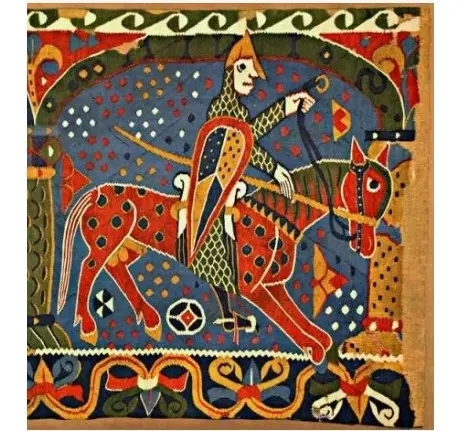
Here he is, the “Latin” horseman of the 12th century in all his glory. Fragment of the tapestry “The Twelve Months” from the Baldishol Church. End of the 12th century Museum of Applied Arts. Oslo. Norway.
From the point of view of the military situation in the East, the enemy of the crusaders, Salah ad-Din, was the natural enemy of Kilych Arslan II, and he in turn became the natural enemy of Salah ad-Din. In 1188–1889, an exchange of embassies took place between Salah ad-Din and Isaac. The parties agreed that a mosque would be opened in Constantinople, and in return the Church of the Holy Sepulcher would be handed over to the Orthodox.
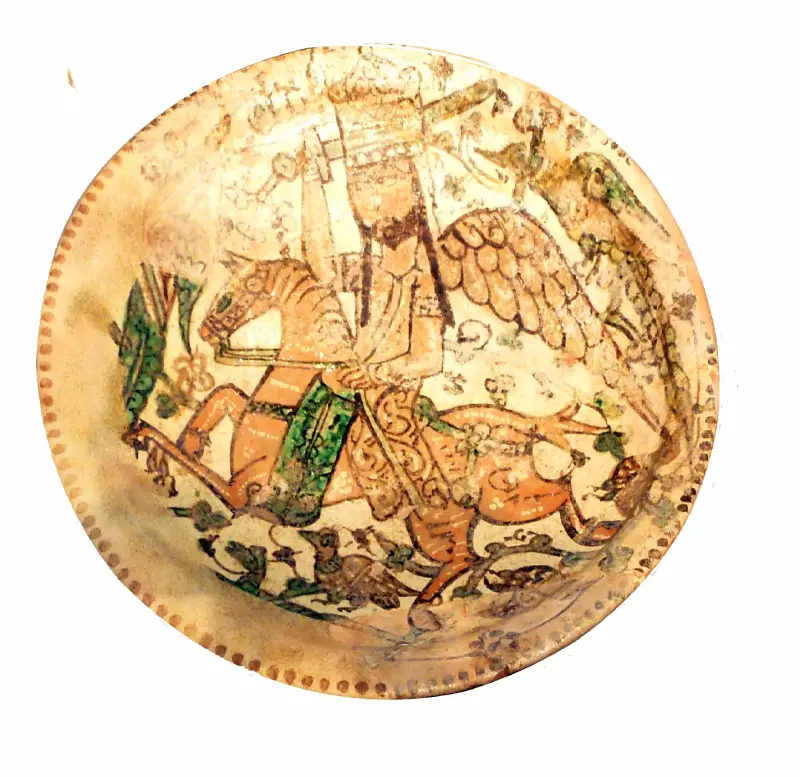
Eastern warrior of the 12th century. Iraq. Plate. Louvre. Paris. France. Photo by the author.
Since the goal of Frederick Barbarossa was the liberation of Jerusalem, he took all precautions along this path. He had previously concluded an alliance in Nuremberg with Isaac Angel. Then he came to an agreement with Kilych Arslan II, the natural enemy of Salah ad-Din, who took Jerusalem from Western Christians.
On July 2, 1189, German pilgrims approached the borders of Byzantium and were warmly received by the emperor's officials. But their path lay through the rebellious lands of the Serbs and Bulgarians, who fought against the empire. Fearing that they would find an ally in the German emperor, the Byzantines spoiled the road through these lands by proposing a workaround. Both the Serbs and the Bulgarians wanted an alliance with Frederick to fight the weakened metropolis, but at the same time their separate detachments attacked the pilgrims. They were ready to accept the protectorate of the Western Emperor if Dalmatia was given to the great zupan of Serbia, Stefan Nemanja (1113–1198), and Bulgaria was given to the Asen brothers. But the German emperor, whose goal was a crusade, refused them.
He followed the old Roman road from Niš, where he met Stefan Nemanja, through Sardica, Philippopolis, Adrianople to the Charisian or Adrianople Gate of Constantinople.
The logothete of the drome, John Ducas, and Andronikos Cantacuzene, being in secret opposition to the basileus, deliberately neglected their responsibilities to help the crusaders: food was not delivered on time, the roads were blocked with trees.
Greek detachments periodically threatened the pilgrims, especially since in their ranks there were many eastern horsemen who did not like the crusaders, forcing them to walk slowly in battle dress in formation.
The crusaders walked a difficult path from the Danube to Sardika (Sofia): in the city they found neither inhabitants nor supplies. But the Serbs and Hungarians helped the Germans. The army marched towards the city of Philippopolis (Plovdiv), constantly clashing with the Romans in the klisurs, fortifications. Half-empty Philippopolis, which had no fortifications due to the stupid orders of the basileus, was occupied, and the army settled in it. And they began to plunder the surrounding area, which, for example, was reported to the basileus by the manager of the town of Branditsa (the modern village of Branitsa, Bulgaria).
Frederick turned to Protostrator Manuel Kamitz with a request to resolve the issue with the emperor and not to attack the German pilgrims, and Isaac Angel, who at the same time feared the powerful army of the Germans, on the other hand, consoled himself with the illusions of a universal empire and former greatness, which had nothing to do with his activities , forced the protostrator to increase pressure on the Germans, and he himself arrested the embassy:
Frederick sent a new embassy. It rescued the first embassy, consisting of the Bishop of Munster, Robert of Nassau and the chamberlain Marquard.
The returning ambassadors said that the Greeks mocked them while they received the envoys of Salah ad-Din in Constantinople. In addition, having attacked the town of Gradec, the Germans showed our images in churches and houses: the Romans sat astride the Latins. The poorly governed feudal freemen and gangs of pilgrims had already plundered enormous wealth, which caused an increase in the cost of food.
While Frederick understood, unlike his obstinate predecessors, kings Conrad and Louis, that he had nothing to do in Asia Minor without the help of the Romans, as in the case of crossing the straits. And he did not aggravate the situation, trying, as far as possible, to smooth it out: the forces that he possessed would be enough to completely defeat Byzantium.
And Isaac, like any narrow-minded person, perceived the restrained behavior of the German emperor as a manifestation of weakness, threatening that from the top of the Blachernae palace, which was part of the city fortifications, he would shoot the Alemanni from a bow with copper arrows. Which made even those close to him laugh.
And Frederick occupied the cities of Adrianople and Dimotika (Didimoticho), the distance between them was 48 km, and approached Constantinople. The attempt of protostrator Manuel Kamitsa to attack him ended in complete failure, the Germans killed all the Alans, and the Greeks fled.
At the same time, the German emperor maintained contact with the Serbs and Bulgarians, because they provided his rear, and in the event of a complete break with Isaac the Angel, they would become a reliable ally in the fight for New Rome. The Bulgarians proposed to gather an army of 1190 thousand, including Polovtsians, by mid-40, in order to force their way into Asia Minor through the straits. They eventually gathered an army, Frederick did without them, and the Bulgarians attacked the Romans.
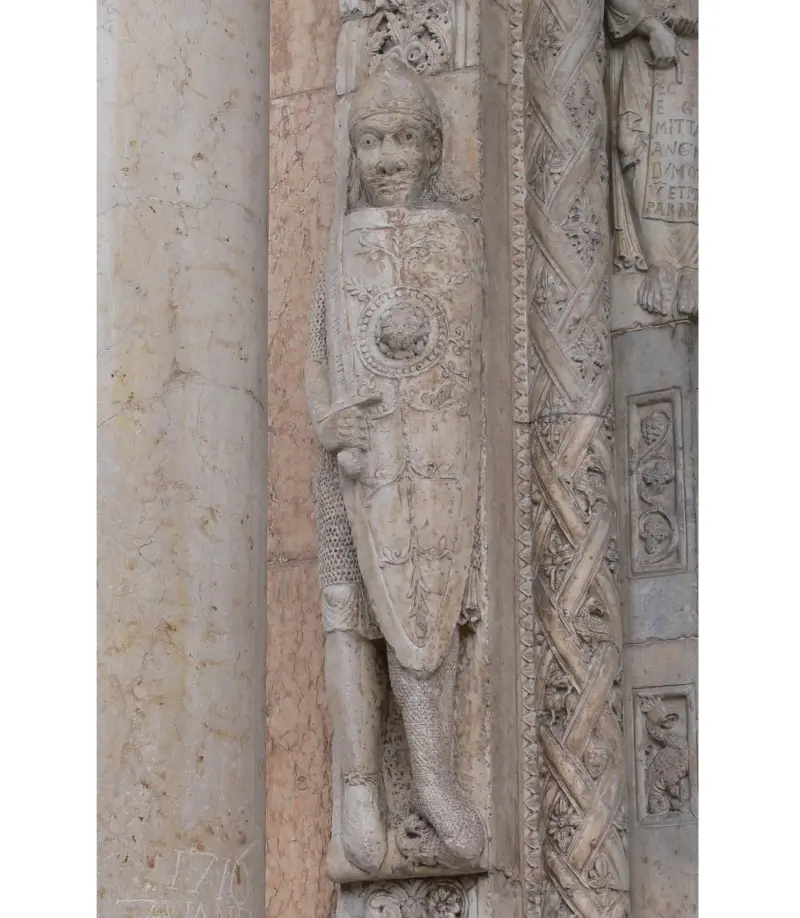
Latin in armor. XII century Cathedral of Our Lady. Duoma di Verona. Italy. Photo by the author.
Finally, Isaac the Angel realized that all the “prophetic predictions” of his monks, seers and ventriloquists regarding Barbarossa were not coming true, and decided to arrange all matters amicably. Now he rewarded the emperor and began to encourage him to cross, to which the German emperor objected, deciding to spend the winter in the European part of the empire. His army remained in Adrianople for the winter, and Frederick remained in Orestiada (Orestias, Greece) 20 km from Adrianople and 260 km from Constantinople. In March, the emperors, fearing each other, entered into an agreement to transport pilgrims to Asia Minor:
On the other hand, the king gave hostages, including several of his blood relatives, and five hundred merchants and royal courtiers swore in the great temple that the king would inviolably maintain the conditions, give the Alemanni guides and provide all the means for their food on the road.
Transportation through the strait was carried out 280 km south of Constantinople. In March 1190, after the celebration of Easter, in the city of Kalliopolis (modern Gelibolu, Turkey), on the European coast, on the Gallipoli Peninsula, a huge number of ships gathered, which transported the entire army to Asia in three days. Frederick demanded just such a method of transportation, fearing the blow of the Romans.
Soon he stormed the capital of the Iconian Sultanate, the main enemy of Byzantium in the east.
And the question of a siege by the crusaders was completely removed, but, as even Frederick Barbarossa supposedly believed, for adequate logistics with the eastern Latin states, Constantinople should have been captured.
To be continued ...
Information